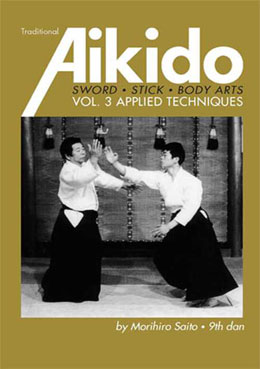APPLIED TECHNIQUES (V3)
Sword - Stick - Body Arts

Front page
Contents
Chapter I — Variation of Kokyu-ho
- Sitting
- i. Basic pattern
- ii. Wrist held from below
- iii. Wrist held from above
- iv. Wrist pinned
- v. Wrist held with full power
- vi. Elbow joints pinned
- Standing
- i. Basic pattern
- ii. Wrist twisted
- iii. Wrist held up
- iv. Wrist held down
- v. Hand grasped on the back
Chapter 2 — Variation of Basic Techniques.
- Suwari waza Shomen Uchi Dai Ikkyo
- i. Omote waza
- ii. Ura waza
- Shomen Uchi Dai Ikkyo
- i. Omote waza
- ii. Ura waza
- Shomen Uchi Dai Nikyo
- i. Omote waza
- ii. Ura waza
- Shomen Uchi Dai Sankyo
- i. Omote waza
- ii. Ura waza
- Shomen Uchi Dai Yonkyo
- i. Omote waza
- ii. Ura waza
- Yokomen Uchi Dai Gokyo
- i. Omote waza
- ii. Ura waza
- Katate Dori Shihonage
- i. Omote waza
- ii. Ura waza
- Ki Flow and blending
- i. Omote waza
- ii. Ura waza
- Katate Dori Shihonage
- Kata dori Shihonage
- Hanmi Handachi Waza Katate dori Shihonage
- Hanmi Handachi Waza Ryote dori Shihonage
- Yokomen Uchi Kotegaeshi
- i. Remarks on Kotegaeshi
- i. Remarks on Kotegaeshi
- Kaitennage Uchi Mawari
- Kaitennage Soto Mawari
- Ki Flow and Blending
- Shomen Uchi Iriminage
- i. Variation !
- ii. Variation 2
- iii. Variation 3
- iv. Remarks on Iriminage
- v. How to perform Iriminage
- Ryote dori Iriminage
- Kata dori Iriminage
- i. When diverting the attack rightwards
- ii. When diverting the attack leftward
- Morote dori Iriminage
- i. When turning the arm from below
- ii. When turning the arm from above
- Hanmi Handachi waza
- i. Shomen Uchi Iriminage
- i. Shomen Uchi Iriminage
- Tenchinage
- Kokyunage
- i. Te kubi (wrist held)
- ii. Sode guchi (cuff held)
- iii. Sode (Sleeve held)
- Kokyunage
- i. Te kubi (wrist held)
- ii. Sode guchi (cuff held)
- iii. Sode (Sleeve held)
- Jyuji garami or Aya Dori
- i. Mune (Lower lapel held)
- ii. Both hands held from below
- iii. Mune held from below
- Ushiro Eri dori Dai Ikkyo
- Ushiro Kokyu nage
- i. Collar held from behind (1)
- ii. Collar held from Behind (2)
Chapter 3 — Modes of Variation.
- Koshi Nage Henka Waza
- i. Koshi nage (1)
- ii. Koshi nage (2)
- iii. Koshi nage (3)
- iv. Koshi nage (4)
- v. Henka Waza (5)
- vi. Henka Waza (6)
- Variations of basics Techniques (Iriminage)
- i. Ushiro Ryote dori
- ii. Ushiro Eri tori
- iii. Ushiro Eri tori
- Ushiro Waza Variations
- i. Ushiro Eri tori Shihonage
- ii. Ushiro Ero tori Kotegaeshi
-Introduction
The third volume in the Traditional Aikido series begins the presentation of the vast subject of taijutsu, that is, the empty-handed techniques of aikido. To quote from the foreword to Volume 3:
“The techniques in this book were picked entirely at the discretion of the author who sought, in selecting them, to establish some contextual correlation between pertinent techniques. Some of the techniques may well be construed as derivatives from the standard Aikido repertory. ‘… As an invaluable aid, I took the liberty to of quoting the words bequeathed by Founder Morihei Uyeshiba, which represent the “heart of techniques” in such a concise and incisive manner.’”
Traditional Aikido, Volume 3, Applied Techniques contains hundreds of high quality photos and over 18 Kuden (secrets of the art bequeathed orally by the Founder Morihei Uyeshiba).
- Hardcover with cotton cover
- Premium silky paper
- Thread tied spine
- Dustcover
- 140 pages
Traditional Aikido volume 3 includes:
- Foreword by Morihiro Saito
- Bodily Adaptation of “principle of swordmanship”
- Body exercise and their unlimited Ramifications